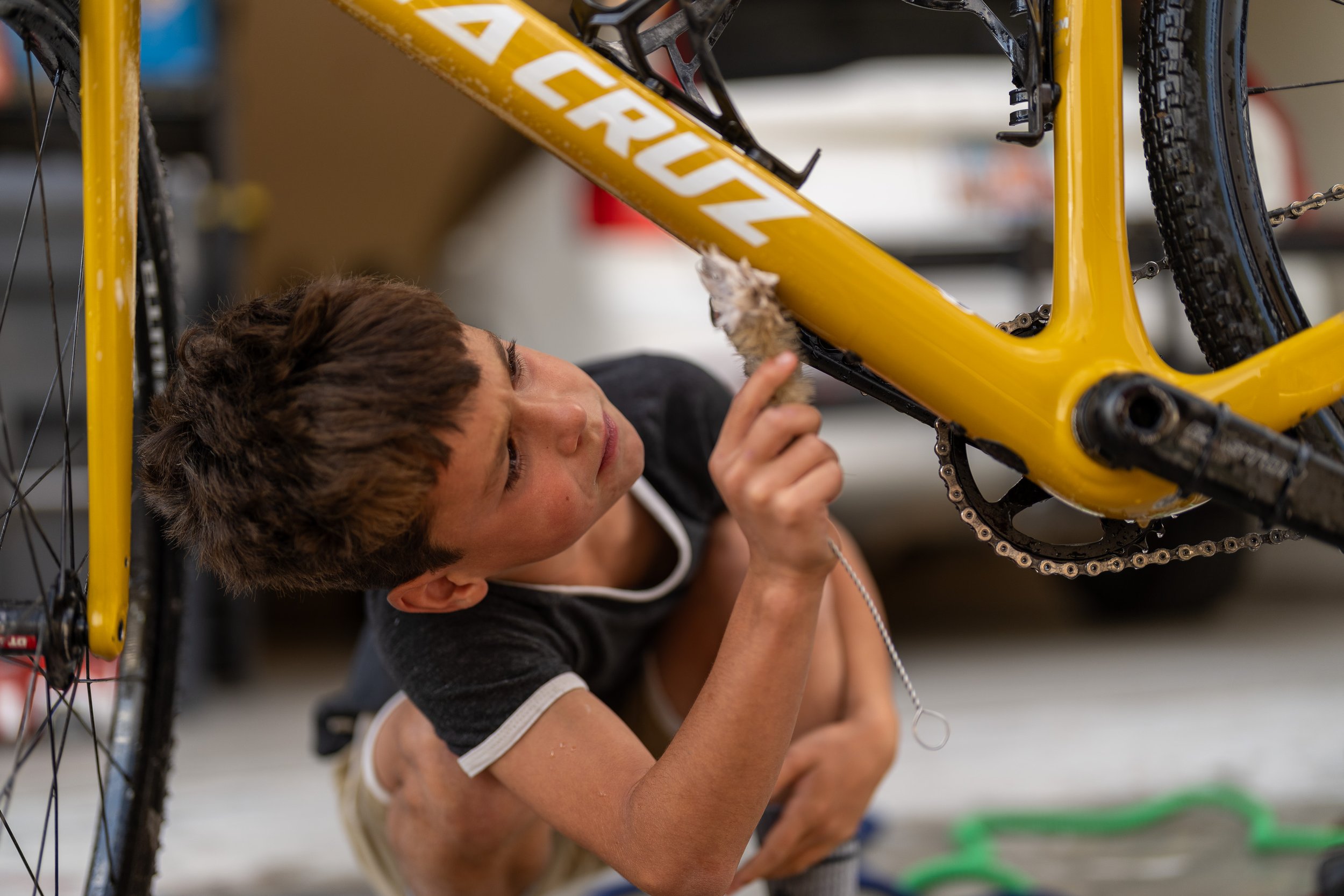In the Quiet Moments // Cultivating Good Habits in Our Children
In the Quiet Moments is a series focusing on the subtle yet impactful moments in parenting and raising children. It's about embracing the silent, often overlooked instances that shape our lives and our children's. In this month’s piece the focus is on how to create healthy habits in you and your children.
PC: @garyschapman
Nurturing Responsibility: Shaping Tomorrow's Adults Today
A question often finds its way to my children in our daily conversations: "What type of person do you want to be?" I ask them. It’s a simple question, yet it carries the weight of countless choices and moments that shape our children's lives. This question emerges in moments of triumph and trial alike.
The other day my son came home from school, pen marks littering his arms and neck. Before I could ask him who marked his body, he quickly replies, shoving his arms under the counter, “They were being nice to me for once.” Internally, I question his choice of friends, his need for their approval, and his inability to stand up for himself. But instead berating him with words, I ask this one question, which serves as a gentle reminder that, ultimately, we all have a choice in who we become.
This isn't about dictating who my children should be; rather, it's about guiding them to understand that their identity is an ongoing narrative, one that they are actively writing each day. Whether it’s choosing how to respond to a sibling's taunt or deciding to stand up for themselves in the face of adversity on the school playground, they have a choice in how to respond which will paint the portrait of their character for years to come.
Reflecting on the Power of Habits and Choices
As a parent, I find myself in the delicate role of a guide rather than a sculptor. I can't force my children into molds of my making; their spirits are their own. I can see that easily as I look back at my own childhood and wonder at how my mother instilled such powerful lessons in me all while sitting on the sidelines of my life. But what I can do is present them with opportunities to think, to choose, and to grow just like she did. It's about setting up scenarios that prompt reflection, not dictating life lessons from a pedestal.
This philosophy hit close to home with my personal commitment to writing. Every 30-minute session of sitting in the chair each morning to write is like adding a coin to my ‘writer’s bucket.' Gradually, these small investments accumulate, slowly transforming my identity. It’s always been hard to call myself a writer because I’ve always written, but never received any monetary income from it. Today, if you asked me, I’d tell you I’m a writer because I’ve practiced the habit of writing for years. This personal journey underscores a profound truth about habits – they're the subtle yet powerful forces that shape our identities over time.
For my children, I hope to instill this understanding. They are not just passive recipients of labels or circumstances. They can challenge the narrative – the 'second child' can forge his own path, distinct and vibrant. They can redefine themselves, one habit, one choice at a time.
In our family, habit tracking has become more than a routine; it's a ritual of commitment to our values. It's a conscious effort to prioritize character-building and personal growth amidst the whirlwind of daily life. This practice is a testament to our belief that, with each action, we cast a vote for the type of person we aspire to be.
Pitfalls of Habit Tracking
While habit tracking is a powerful tool in our family's journey towards personal growth and responsibility, it's crucial to recognize its potential pitfalls. This awareness helps us use habit tracking as a means of nurturing, not controlling, our lives and those of our children.
The Perfectionism Trap: Both my eldest child and I have tendencies towards perfectionism. It's easy to fall into the trap of seeing habit tracking as a pursuit of flawless execution. However, we're learning to shift our focus towards consistency rather than perfection. Aiming for an 80% success rate in our weekly habits allows us to hold ourselves accountable without the pressure of being perfect. This approach teaches my children that it's okay to make mistakes and that consistency, not perfection, is key.
Dealing with Feelings of Failure: There are times when falling short in our habit tracking can evoke feelings of failure, tempting us to abandon the practice altogether. "If I can't do it perfectly, why do it at all?" This mindset, however, misses the point. The objective isn't to adhere rigidly to a habit but to learn and grow from the process. For example, we may be traveling and miss a week completely in our daily habits. By demonstrating resilience in the face of setbacks, I hope to teach my children that the journey is more important than the destination. Easier said, right?
Balancing Realistic Expectations: I once tracked my ability to stay on task during a work-from-home day and was surprised by the outcome. Between phone calls, errands, meals, and piano practice, I found little time for focused writing. This experiment was an eye-opener. It's essential to ask ourselves: Are we overestimating our accomplishments or pushing ourselves too hard to maintain a near-perfect success rate? Finding a healthy balance is key. Starting small and setting realistic expectations can prevent the frustration that comes from underestimating tasks or overcommitting ourselves. Example being: instead of committing a child to playing piano 7 days a week, try for 5. Personally, I plan to write in 30 min. chunks instead of hours at a time.
In conclusion, while habit tracking is a valuable practice in our family, it's essential to approach it with a flexible, forgiving mindset especially when children are involved. Growth is a gradual, and many times an imperfect, process. Find a way to make it fun!
Empowering Children with Responsibility: Age-Appropriate Strategies
For Younger Children (Ages 3-6)
Simple Chores: Start with manageable tasks such as tidying up toys, feeding a pet, or getting dressed by themselves. These activities not only teach responsibility but also foster a sense of accomplishment.
Character Building: Recognize and celebrate acts of kindness, sharing, listening, and respect. Positive reinforcement for these behaviors encourages a foundation of good character.
Establishing Routine: Create a straightforward daily schedule that young children can understand and follow. Consistency helps them grasp the concept of time management and reliability.
For Older Children (Ages 7-12)
Increased Responsibilities: As children grow, so should their responsibilities. Encourage them to assist with meal preparation, manage their homework independently, and take care of personal belongings, including sports equipment or musical instruments.
Guided Decision-Making: Provide opportunities for them to make choices, from selecting what to wear to deciding how to spend their free time. Discuss the outcomes of their decisions to teach them about consequences and accountability.
Cultivating Character Through Habits
For habits related to character development, it's essential to make them tangible and trackable. For instance, if I wish for my youngest to embody kindness, we use our habit tracker to note instances during the week where he demonstrates compassion and self-control. This visual reminder helps him recognize his capacity for kindness, even in moments of anger.
How to Create a Wall Habit Tracker: A Monthly Guide
Step 1: Choose Your Habits
Identify Habits: Start by selecting a manageable list of daily positive habits tailored to age appropriateness and individual interests. We pick 3 each month to work on per person. These habits can span various categories such as physical health, mental well-being, responsibilities, and personal hobbies. Remember, no habit is too small to track.
Create Specific Goals: For example in the month of January my 8yo’s 3 goals:
Play piano 4x per week for 30 min.
Exercise 4x per week
Practice Spanish 4x per week for 15 min.
Step 2: Craft Your Habit Tracker
Design and Decoration: Embrace the creative process of designing your habit tracker or purchase one on Etsy. You can use a large piece of poster board, a whiteboard, or even a digital template if you prefer something less permanent. Pick what you’ll use to mark an accomplished goal, we just use stars
Layout: Divide your tracker into columns for each habit and rows for the days of the month. Ensure each cell is large enough to mark or write in. You might also want to leave space for additional notes or achievements.
Step 3: Choose a Display Location
Visibility: This is more important than I initially realized. Pick a spot in your home where the habit tracker is easily visible to all family members. I used to keep ours hidden in the pantry but we all forgot about it. A common area like the kitchen or living room is ideal. Ours is by our garage door and the kitchen and the boys walk past it to head downstairs to their rooms.
Accessibility: Make sure all family members can actually reach it. I have a stool under mine. Think Montessori-style.
Organize Supplies: Attach a small container or holder near the tracker to keep pens, markers, or stickers handy. This minimizes the chances of forgetting to update the tracker due to missing supplies.
Step 4: Fill Out Your Chart Daily
Daily Updates: I encourage my kids to mark their progress daily while I’m making dinner. “It’s getting late, have you completed the habits you wanted to do today?”
Review and Reflect: Before the end of each month, say halfway through take time as a family to review the tracker. We do this over dinner. I might say, “Remind me what you’re saving for?” Reminding them of their “why.”
Discuss challenges: My eldest was working really hard but unable to play piano 7 days a week. Halfway through the month I dropped the commitment to 5 showing him that I wanted him to succeed.
Step 5: Reward the Positive
Celebrate Achievements: At the end of each week (on Saturday for us) we recognize who accomplished their goals. Celebrate the completion of habits, whether it's with verbal praise, a small reward, or a family activity. This reinforces the positive impact of maintaining good habits.
Choose Reward: We don’t give our children allowance, but we do give a small monetary reward for accomplishing habits. Teaching them to save and working towards a larger goal in mind. This is what our family has found useful. Choose what works for you.
Bonus Tips:
Flexibility: Be willing to adjust your habits or the tracker itself as you discover what works best for your family.
Involvement: Get everyone involved in the process. My husband doesn’t track habits but he’s in charge on rewarding and celebrating at the end of the month.
Consistency: While perfection is not the goal, aim for consistency. It's okay if some days are missed; what's important is the effort and progress made over time.
Continually Reassess: Sometimes we keep the same habit for months. Other times we switch them out monthly. Again, tailor this to your family’s needs.









